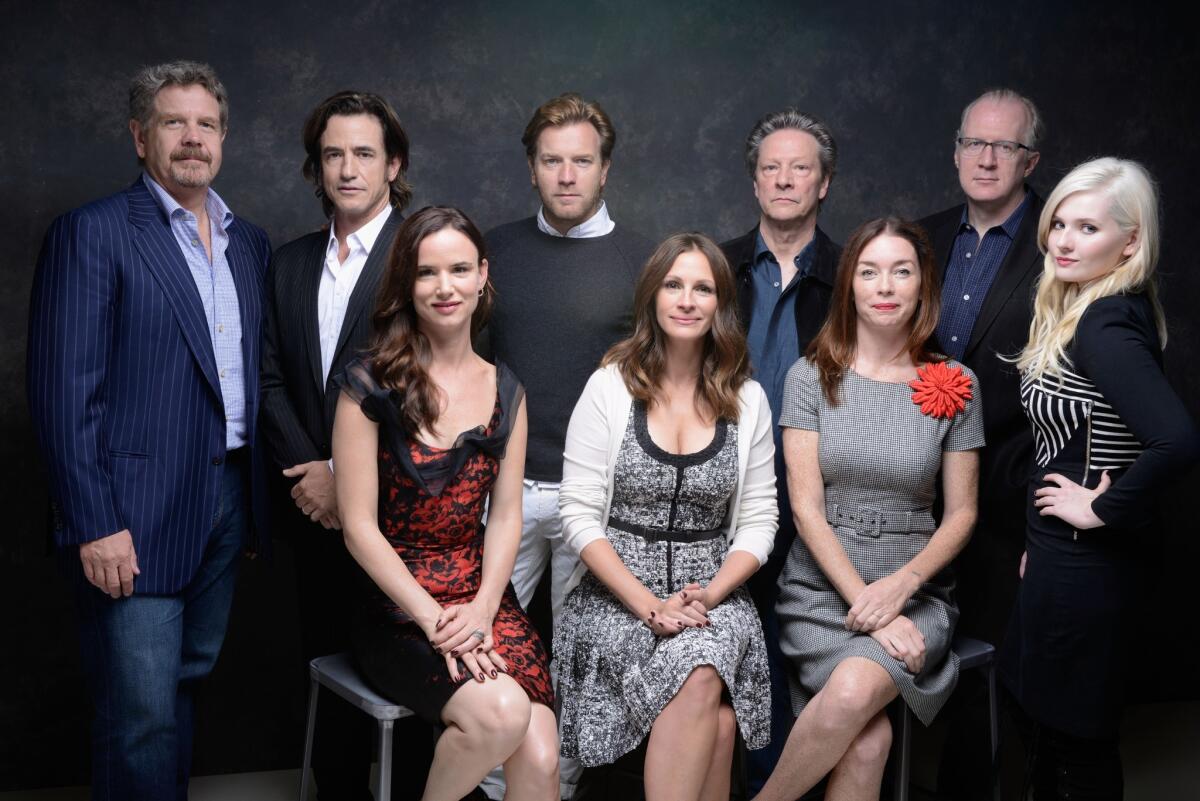TIFF 2013: ‘August: Osage County’ ending could be changed for release

[Warning: This post contains plot spoilers about the upcoming movie “August: Osage County.” While we don’t think they’ll ruin the experience, you might be mad anyway. Please read at your own risk.]
TORONTO -- If you saw Tracy Letts’ Pulitzer Prize-winning black comedy “August: Osage County” on the stage in any of the numerous cities it played a few years back, chances are you were struck by one scene above all else. The final one, that is, in which matriarch Violet Weston is seen sitting on the stairs of the house she once ruled, abandoned by her adult daughters, especially eldest daughter Barbara, who don’t/can’t/won’t stay and take care of a woman who, let’s face it, has made her and her sisters’ lives pretty miserable.
For those who saw the John Wells-directed (and Letts-scripted) movie at the Toronto International Film Festival this week, a different ending awaited.
PHOTOS: Hollywood backlot moments
Violet, played by Meryl Streep, is indeed shown toward the end of the action in the house she once ruled, calling for the Native American nurse who serves as the sort of eyes and ears of the audience. But the film doesn’t end with the play’s iconic image of Violet on the stairs. Instead, in the following scene, Barbara, played by Julia Roberts, can be seen driving away, conveying in a rather different way she’s leaving her mother and shifting the focus to the younger character.
It’s impossible not to notice the difference, and filmgoers exiting the premiere were buzzing/arguing/complaining about the movie’s final scene.
But here’s the thing: It might not be the movie’s final scene.
Wells and Letts are still in a push-pull with producers and Weinstein Co. executives over whether the movie should end in the current manner, as many in the latter camp want, or with a shot of Violet in the manner of the play, as Letts and Wells have long learned toward.
In fact, in his first cut Wells left the ending as it was on the stage -- with the shot of Violet on the stairs. But when the film was screened for early audiences they didn’t approve.
“We tested it over and over again and people rebelled in the theater,” Wells said in an interview Tuesday. “They were terrified about what happened to Barbara.”
PHOTOS: Celebrities by The Times
Keeping it the way it was in the play, he said, was just too alienating to the people the film needed to appeal to.
“They felt like we were hitting them on the head with a hammer. I heard it over and over again -- to the point that it was ‘Let’s see what happens if we put Violet on the steps and then cut to Barbara.”
That went over better, with audiences now saying they had more closure with the daughter character. And so, in went the final ending for Toronto.
But that result -- though blessed by Weinstein -- isn’t something Wells is convinced of. And he may yet triumph in his bid to revert to the other ending.
“I’m not sure I’m OK with doing it that way,” he said. “I don’t want to say there’s anything wrong with the current ending, because there isn’t. But it’s something we’re still talking about. We don’t open for three months, and it’s possible you’ll see something different.”
A Weinstein Co. spokesman was not immediately available for comment.
FULL COVERAGE: Film Festivals
In an interview alongside Wells, Letts agreed but struck a somewhat more ambivalent note. He said he felt there was something stark and powerful about ending with Violet on the stairs -- that’s how he wrote it for the stage, after all -- but he also said that closing with a Barbara drive scene was OK if it clarified the matter for viewers.
“A little ambiguity is not a bad thing,” he said. “But we don’t want audience confusion, where it’s suddenly ‘I don’t know where the ball is.’ So this is what we’re trying to figure out.”
Why audiences were OK with a Violet-centric ending on the stage but not the screen remains an open question. Letts wryly suggested that it’s because the play didn’t afford the option; he couldn’t very well show Barbara offstage in a prop car that she pretend-drove.
Whatever the reason, there’s more at stake than just the plot point, though the idea of focusing on Barbara’s leaving instead of Violet’s solitude has some implications in its own right. There’s something of a fundamental question about the ending: How much freedom should creators have in adapting a work as they see fit. It’s a question that transcends this piece and, indeed, stage-to-screen adaptations generally. Should those putting a new spin on a popular entertainment brand be given wide latitude to make the choices they want to make? It’s been a question turning up a lot lately, from the Ben Affleck’s Batman casting to -- why not? --- Miley Cyrus twerking her image.
The “August” ending also raises a curious wrinkle in the world of filmmaking. As Wells noted, not that long ago, when film was still presented on film, once a cut was locked it was locked. It cost a hundred or two hundred grand to change it, which allowed little last-minute dithering over an ending. But like so many other things that have gone digital, from Web journalism to cable news coverage, a finished story is never really finished
At the close of the “August: Osage County” movie, Meryl Streep is, symbolically speaking, standing alone. Does Julia drive? The Weinsteins and its director are, for all the film-festival chatter, still hashing it out.
ALSO:
TIFF 2013: ‘Labor Day’ has Jason Reitman toiling anew’
Sandra Bullock calls making ‘Gravity’ lonely
‘Dallas Buyers Club’ reaches next destination
Follow me on Twitter at https://twitter.com/ZeitchikLAT
More to Read
Only good movies
Get the Indie Focus newsletter, Mark Olsen's weekly guide to the world of cinema.
You may occasionally receive promotional content from the Los Angeles Times.







